Interlinkages between Climate Change Impacts, Public Attitudes, and Climate Action—Exploring Trends before and after the Paris Agreement in the EU
Abstract
1. Introduction
2. Literature Review
2.1. Climate Change Impacts—The Trends
2.2. Climate Change Policy—The Trends
2.3. Public Attitudes towards Climate Change—The Trends
2.4. Climate Change Impacts and Public Attitudes towards Climate Change
2.5. Climate Change Impacts and Climate Change Policy
2.6. Public Attitudes towards Climate Change and Climate Change Policy
2.7. Few Papers Examined the Nexus between Climate Impacts, Public Attitudes, and Climate Policy
- RQ1: Is there a relationship between drought/heat stress and climate policy? If so, what is the nature of the relationship?
- RQ2: Is there a relationship between public attitudes towards climate change and climate policy? If so, what is the nature of the relationship?
3. Methods
3.1. Climate Impacts
3.2. Public Attitudes
3.3. Climate Change Policy
3.4. Analysis
4. Results
4.1. PART A: Descriptive Overview of the Three Domains (Climate Change Policy, Public Attitudes, Climate Impacts) at the EU Level and the Macro-Regional Level
- 1.
- Climate Change Policies
- 2.
- Public attitudes regarding climate change
- 3.
- Climate impacts—E3CI
4.2. PART B: Analysis of Multiple Domains at the EU Level Using Linear Models
- 4.
- Climate impacts and climate policies
5. Public Attitudes and Climate Policies
6. Discussion
7. Limitations
8. Conclusions
Supplementary Materials
Author Contributions
Funding
Data Availability Statement
Acknowledgments
Conflicts of Interest
References
- Statista. Emissions in the EU—Statistics & Facts|Statista. 15 August 2022. Available online: https://www.statista.com/topics/4958/emissions-in-the-european-union/#dossierKeyfigures (accessed on 15 April 2023).
- Poortinga, W.; Whitmarsh, L.; Steg, L.; Böhm, G.; Fisher, S. Climate change perceptions and their individual-level determinants: A cross-European analysis. Glob. Environ. Change 2019, 55, 25–35. [Google Scholar] [CrossRef]
- Oberthür, S.; Groen, L. The European Union and the Paris Agreement: Leader, mediator, or bystander? Wiley Interdiscip. Rev. Clim. Change 2017, 8, e445. [Google Scholar] [CrossRef]
- Nongqayi, L.; Risenga, I.; Dukhan, S. Youth’s knowledge and awareness of human contribution to climate change: The influence of social and cultural contexts within a developing country. Educ. Dev. Psychol. 2022, 3, 44–57. [Google Scholar] [CrossRef]
- Cowls, J.; Tsamados, A.; Taddeo, M.; Floridi, L. The AI gambit: Leveraging artificial intelligence to combat climate change—Opportunities, challenges, and recommendations. AI Soc. 2023, 38, 283–307. [Google Scholar] [CrossRef] [PubMed]
- Climate Action Tracker. Climate target updates slow as science ramps up need for action. In Climate Action Tracker Global Update September. 2021. Available online: https://climateactiontracker.org/documents/871/CAT_2021-09_Briefing_GlobalUpdate.pdf (accessed on 15 April 2023).
- Constantino, S.M.; Sparkman, G.; Kraft-Todd, G.T.; Bicchieri, C.; Centola, D.; Shell-Duncan, B.; Vogt, S.; Weber, E.U. Scaling Up Change: A Critical Review and Practical Guide to Harnessing Social Norms for Climate Action. Psychol. Sci. Public Interest 2022, 23, 50–97. [Google Scholar] [CrossRef] [PubMed]
- World Meteorological Organization. The State of the Global Climate 2021|World Meteorological Organization. 2021. Available online: https://public.wmo.int/en/our-mandate/climate/wmo-statement-state-of-global-climate (accessed on 15 April 2023).
- Jungmann, M.; Vardag, S.N.; Kutzner, F.; Keppler, F.; Schmidt, M.; Aeschbach, N.; Gerhard, U.; Zipf, A.; Lautenbach, S.; Siegmund, A.; et al. Zooming-in for climate action—Hyperlocal greenhouse gas data for mitigation action? Clim. Action 2022, 1, 1–8. [Google Scholar] [CrossRef]
- Ponthieu, E. The European Green Deal and Other Climate Plans. In The Climate Crisis, Democracy and Governance; Springer: Berlin/Heidelberg, Germany, 2020; pp. 17–36. [Google Scholar] [CrossRef]
- Knutti, R. Closing the Knowledge-Action Gap in Climate Change. One Earth 2019, 1, 21–23. [Google Scholar] [CrossRef]
- IPCC. Climate Change 2021: The Physical Science Basis. Contribution of Working Group I to the Sixth Assessment Report of the Intergovernmental Panel on Climate Change; Masson-Delmotte, B.Z., Zhai, P., Pirani, A., Connors, S.L., Péan, C., Berger, S., Caud, N., Chen, Y., Goldfarb, L., Gomis, M.I., et al., Eds.; Cambridge University Press: Cambridge, UK, 2021; Available online: https://www.ipcc.ch/assessment-report/ar6/ (accessed on 15 April 2023).
- IPCC. Climate Change 2022: Impacts, Adaptation and Vulnerability. In Contribution of Working Group II to the Sixth Assessment Report of the Intergovernmental Panel on Climate Change; Pörtner, H.-O., Roberts, D.C., Tignor, M., Poloczanska, E.S., Mintenbeck, K., Alegría, A., Craig, M., Langsdorf, S., Löschke, S., Möller, V., et al., Eds.; Cambridge University Press: Cambridge, UK, 2022. [Google Scholar]
- Lamb, W.; Grubb, M.; Diluiso, F.; Minx, J. Countries with sustained greenhouse gas emissions reductions: An analysis of trends and progress by sector. Clim. Policy 2022, 22, 1–17. [Google Scholar] [CrossRef]
- European Parliament. EU Progress towards 2020 Climate Change Goals (Infographic)|News|European Parliament. 2022. Available online: https://www.europarl.europa.eu/news/en/headlines/society/20180706STO07407/eu-progress-towards-2020-climate-change-goals-infographic (accessed on 15 April 2023).
- Davidovic, D.; Harring, N. Exploring the cross-national variation in public support for climate policies in Europe: The role of quality of government and trust. Energy Res. Soc. Sci. 2020, 70, 101785. [Google Scholar] [CrossRef]
- Deutch, J. Is Net Zero Carbon 2050 Possible? Joule 2020, 4, 2237–2240. [Google Scholar] [CrossRef]
- Poschmann, J.; Bach, V.; Finkbeiner, M. Are the EU climate ambitions reflected on member-state level for greenhouse gas reductions and renewable energy consumption shares? Energy Strategy Rev. 2022, 43, 100936. [Google Scholar] [CrossRef]
- Ricart, S.; Olcina, J.; Rico, A.M. Evaluating Public Attitudes and Farmers’ Beliefs towards Climate Change Adaptation: Awareness, Perception, and Populism at European Level. Land 2018, 8, 4. [Google Scholar] [CrossRef]
- Jakučionytė-Skodienė, M.; Liobikienė, G. The Changes in Climate Change Concern, Responsibility Assumption and Impact on Climate-friendly Behaviour in EU from the Paris Agreement Until 2019. Environ. Manag. 2022, 69, 1–16. [Google Scholar] [CrossRef]
- Poortinga, W.; Fisher, S.; Bohm, G.; Steg, L.; Whitmarsh, L. European Attitudes to Climate Change and Energy. Topline Results from Round 8 of the European Social Survey; European Social Survey ERIC: London, UK, 2018. [Google Scholar]
- Arıkan, G.; Günay, D. Public attitudes towards climate change: A cross-country analysis. Br. J. Politics Int. Relat. 2021, 23, 158–174. [Google Scholar] [CrossRef]
- Aguiar, F.C.; Bentz, J.; Silva, J.M.N.; Fonseca, A.L.; Swart, R.; Santos, F.D.; Penha-Lopes, G. Adaptation to climate change at local level in Europe: An overview. Environ. Sci. Policy 2018, 86, 38–63. [Google Scholar] [CrossRef]
- Otto-Banaszak, I.; Matczak, P.; Wesseler, J.; Wechsung, F. Different perceptions of adaptation to climate change: A mental model approach applied to the evidence from expert interviews. Reg. Environ. Change 2011, 11, 217–228. [Google Scholar] [CrossRef]
- Kundzewicz, Z.W.; Matczak, P.; Otto, I.M.; Otto, P.E. From “atmosfear” to climate action. Environ. Sci. Policy 2020, 105, 75–83. [Google Scholar] [CrossRef]
- Pfeifer, L.; Otto, I.M. Changing seasonal temperature offers a window of opportunity for stricter climate policy. Environ. Sci. Policy 2023, 140, 35–45. [Google Scholar] [CrossRef]
- Van Boven, L.; Sherman, D.K. Elite influence on public attitudes about climate policy. Curr. Opin. Behav. Sci. 2021, 42, 83–88. [Google Scholar] [CrossRef]
- Burck, J.; Marten, F.; Bals, C.; Uhlich, T.; Höhne, N.; Gonzales, S.; Moisio, M. Climate Change Performance Index. 2017. Available online: www.germanwatch.org/en/ccpi (accessed on 15 April 2023).
- IFAB. E3CI: European Extreme Events Climate Index. 2021. Available online: https://www.ifabfoundation.org/e3ci/ (accessed on 15 April 2023).
- European Commission; Directorate-General for Communication. Special Eurobarometer 372: Social Climate (v1.00). 2014. Available online: http://data.europa.eu/88u/dataset/S1007_75_4_EBS372 (accessed on 15 April 2023).
- European Commission; Directorate-General for Communication. Special Eurobarometer 409: Climate Change (v1.00). 2014. Available online: http://data.europa.eu/88u/dataset/S1084_80_2_409 (accessed on 15 April 2023).
- European Commission; Directorate-General for Communication. Special Eurobarometer 459: Climate Change (v1.00). 2017. Available online: http://data.europa.eu/88u/dataset/S2140_87_1_459_ENG (accessed on 15 April 2023).
- European Commission; Directorate-General for Communication. Special Eurobarometer 490: Climate Change (v1.00). 2019. Available online: http://data.europa.eu/88u/dataset/S2212_91_3_490_ENG (accessed on 15 April 2023).
- European Commission; Directorate-General for Communication. Special Eurobarometer 513: Climate CHANGE (v1.00). 2021. Available online: http://data.europa.eu/88u/dataset/S2273_95_1_513_ENG (accessed on 15 April 2023).
- IPCC. Managing the Risks of Extreme Events and Disasters to Advance Climate Change Adaptation. In A Special Report of Working Groups I and II of the Intergovernmental Panel on Climate Change; Field, C.B., Barros, V., Stocker, A., Qin, D., Dokken, D.J., Ebi, K.L., Mastrandrea, M.D., Mach, K.J., Plattner, G.-K., Allen, S.K., et al., Eds.; Cambridge University Press: Cambridge, UK, 2012. [Google Scholar] [CrossRef]
- IPCC. Summary for Policymakers. In Climate Change 2021: The Physical Science Basis. Contribution of Working Group I to the Sixth Assessment Report of the Intergovernmental Panel on Climate Change; Masson-Delmotte, B.Z., Zhai, P., Pirani, A., Connors, S.L., Péan, C., Berger, S., Caud, N., Chen, Y., Goldfarb, L., Gomis, M.I., et al., Eds.; Cambridge University Press: Cambridge, UK, 2021; pp. 3–32. [Google Scholar]
- Seneviratne, S.I.; Zhang, X.; Adnan, M.; Badi, W.; Dereczynski, C.; Di Luca, A.; Ghosh, S.; Iskandar, I.; Kossin, J.; Lewis, S.; et al. Weather and Climate Extreme Events in a Changing Climate. In Climate Change 2021: The Physical Science Basis. Contribution of Working Group I to the Sixth Assessment Report of the Intergovernmental Panel on Climate Change; Masson-Delmotte, B.Z., Zhai, P., Pirani, A., Connors, S.L., Péan, C., Berger, S., Caud, N., Chen, Y., Goldfarb, L., Gomis, M.I., et al., Eds.; Cambridge University Press: Cambridge, UK, 2021; pp. 1513–1766. [Google Scholar]
- Mckee, T.B.; Doesken, N.J.; Kleist, J. The relationship of drought frequency and duration to time scales. In Proceedings of the 8th Conference on Applied Climatology, Anaheim, CA, USA, 17–22 January 1993; pp. 179–184. [Google Scholar]
- Hersbach, H.; Bell, B.; Berrisford, P.; Hirahara, S.; Horányi, A.; Muñoz-Sabater, J.; Nicolas, J.; Peubey, C.; Radu, R.; Schepers, D.; et al. The ERA5 global reanalysis. Q. J. R. Meteorol. Soc. 2020, 146, 1999–2049. [Google Scholar] [CrossRef]
- ESSL. ESWD: European Severe Weather Database. 2018. Available online: https://eswd.eu/ (accessed on 15 April 2023).
- EFFIS. FWI: European Extreme Events Climate Index. 2022. Available online: https://climate.copernicus.eu/fire-weather-index (accessed on 15 April 2023).
- Roberts, J.F.; Champion, A.J.; Dawkins, L.C.; Hodges, K.I.; Shaffrey, L.C.; Stephenson, D.B.; Stringer, M.A.; Thornton, H.E.; Youngman, B.D. The XWS open access catalogue of extreme European windstorms from 1979 to 2012. Nat. Hazards Earth Syst. Sci. 2014, 14, 2487–2501. [Google Scholar] [CrossRef]
- Hilgard, E.R. The trilogy of mind: Cognition, affection, and conation. J. Hist. Behav. Sci. 1980, 16, 107–117. [Google Scholar] [CrossRef] [PubMed]
- Lenton, T.M. Early warning of climate tipping points. Nat. Clim. Change 2011, 1, 201–209. [Google Scholar] [CrossRef]
- Lenton, T.M.; Rockström, J.; Gaffney, O.; Rahmstorf, S.; Richardson, K.; Steffen, W.; Schellnhuber, H.J. Climate tipping points —Too risky to bet against. Nature 2019, 575, 592–595. [Google Scholar] [CrossRef] [PubMed]
- Peterson, L. Silver lining to extreme weather events? Democracy and climate change mitigation. Glob. Environ. Politics 2020, 21, 23–44. [Google Scholar] [CrossRef]
- Urgenda Foundation v. The State of the Netherlands. Available online: https://elaw.org/nl.urgenda.15 (accessed on 20 December 2019).
- Friends of the Irish Environment v. The Government of Ireland. 21 July 2020. Available online: https://ie.vlex.com/vid/friends-of-the-irish-847734616 (accessed on 15 April 2023).
- Conversi, D. The Ultimate Challenge: Nationalism and Climate Change. Natl. Pap. 2020, 48, 625–636. [Google Scholar] [CrossRef]
- Peel, M.C.; Finlayson, B.L.; McMahon, T.A. Updated world map of the Köppen-Geiger climate classification. Hydrol. Earth Syst. Sci. 2007, 11, 1633–1644. [Google Scholar] [CrossRef]
- Hoffmann, R.; Muttarak, R.; Peisker, J.; Stanig, P. Climate change experiences raise environmental concerns and promote Green voting. Nat. Clim. Change 2022, 12, 148–155. [Google Scholar] [CrossRef]
- Giordono, L.; Boudet, H.; Gard-Murray, A. Local adaptation policy responses to extreme weather events. Policy Sci. 2020, 53, 609–636. [Google Scholar] [CrossRef]
- Brosch, T. Affect and emotions as drivers of climate change perception and action: A review. Curr. Opin. Behav. Sci. 2021, 42, 15–21. [Google Scholar] [CrossRef]
- Chapman, D.A.; Lickel, B.; Markowitz, E.M. Reassessing emotion in climate change communication. Nat. Clim. Change 2017, 7, 850–852. [Google Scholar] [CrossRef]
- Rousell, D.; Cutter-Mackenzie-Knowles, A. A systematic review of climate change education: Giving children and young people a ‘voice’ and a ‘hand’ in redressing climate change. Child. Geogr. 2020, 18, 191–208. [Google Scholar] [CrossRef]
- Senevirathne, M.; Amaratunga, D.; Haigh, R.; Kumer, D.; Kaklauskas, A. A common framework for MOOC curricular development in climate change education—Findings and adaptations under the BECK project for higher education institutions in Europe and Asia. Prog. Disaster Sci. 2022, 14, 100222. [Google Scholar] [CrossRef]
- Hase, V.; Mahl, D.; Schäfer, M.S.; Keller, T.R. Climate change in news media across the globe: An automated analysis of issue attention and themes in climate change coverage in 10 countries (2006–2018). Glob. Environ. Change 2021, 70, 102353. [Google Scholar] [CrossRef]
- Le Coq, C.; Paltseva, E. Green Concerns and Salience of Environmental Issues in Eastern Europe. 2021. Available online: https://www.hhs.se/en/about-us/news/site-publications/publications/2021/green-concerns-and-salience-of-environmental-issues-in-eastern-europe/ (accessed on 15 April 2023).
- Hinds, S.; Benoit-Rohmer, F. The European Union Approach to Disinformation and Misinformation: The Case of the 2019 European Parliament Elections. Master’s Thesis, University of Strasbourg, Strasbourg, France, 2019. [Google Scholar] [CrossRef]
- Farrell, J.; McConnell, K.; Brulle, R. Evidence-based strategies to combat scientific misinformation. Nat. Clim. Change 2019, 9, 191–195. [Google Scholar] [CrossRef]
- Malešević, S. Grounded Nationalisms; Cambridge University Press: Cambridge, MA, USA, 2019. [Google Scholar] [CrossRef]
- Brown, K.; Adger, W.N.; Cinner, J.E. Moving climate change beyond the tragedy of the commons. Glob. Environ. Change 2018, 54, 61–63. [Google Scholar] [CrossRef]
- Posocco, L.; Watson, I. Reflexive Green Nationalism (RGN): A sociological antidote to the climate crisis? Front. Sociol. 2022, 7, 1021641. [Google Scholar] [CrossRef]
- Conversi, D.; Posocco, L. Which nationalism for the anthropocene? A comparative study of exemplary green nation-states. Front. Political Sci. 2022, 36. [Google Scholar] [CrossRef]
- Posocco, L.; McNeill, J.R. Climate change: Comparing “green” and “polluting” nation-states. Front. Sociol. 2023, 8, 1133333. [Google Scholar] [CrossRef]
- Conversi, D. Ernest Gellner in the Anthropocene. Modernity, nationalism and climate change. In Ernest Gellner Legacy and Social Theory Today; Skalník, P., Ed.; Springer: New York, NY, USA, 2022. [Google Scholar]
- Brubaker, R. Grounds for Difference; Harvard University Press: Cambridge, MA, USA, 2015. [Google Scholar]
- Demski, C.; Poortinga, W.; Whitmarsh, L.; Böhm, G.; Fisher, S.; Steg, L.; Umit, R.; Jokinen, P.; Pohjolainen, P. National context is a key determinant of energy security concerns across Europe. Nat. Energy 2018, 3, 882–888. [Google Scholar] [CrossRef]
- Lo, A.Y.; Chow, A.T. The relationship between climate change concern and national wealth. Clim. Change 2015, 131, 335–348. [Google Scholar] [CrossRef]
- Zuazua Ruiz, A.; Martín Martín, J.M.; Prados-Castillo, J.F. The European Union facing climate change: A window of opportunity for technological development and entrepreneurship. Sustain. Technol. Entrep. 2023, 2, 100035. [Google Scholar] [CrossRef]
- Schokker, J.; Kamilaris, A.; Karatsiolis, S. A Review on Key Performance Indicators for Climate Change. In Advances and New Trends in Environmental Informatics; Springer: Berlin/Heidelberg, Germany, 2022; pp. 273–292. [Google Scholar] [CrossRef]
- Burck, J.; Uhlich, T.; Bals, C.; Höhne, N.; Nascimento, L. CCPI Background and Methodology. 2023. Available online: www.newclimate.org (accessed on 15 April 2023).
- van Buuren, A.; Gerrits, L. Decisions as dynamic equilibriums in erratic policy processes: Positive and negative feedback as drivers of non-linear policy dynamics. Public Manag. Rev. 2008, 10, 381–399. [Google Scholar] [CrossRef]
- Gladwell, M. The Tipping Point: How Little Things Can Make a Big Difference; Little, Brown and Company: London, UK, 2000. [Google Scholar]
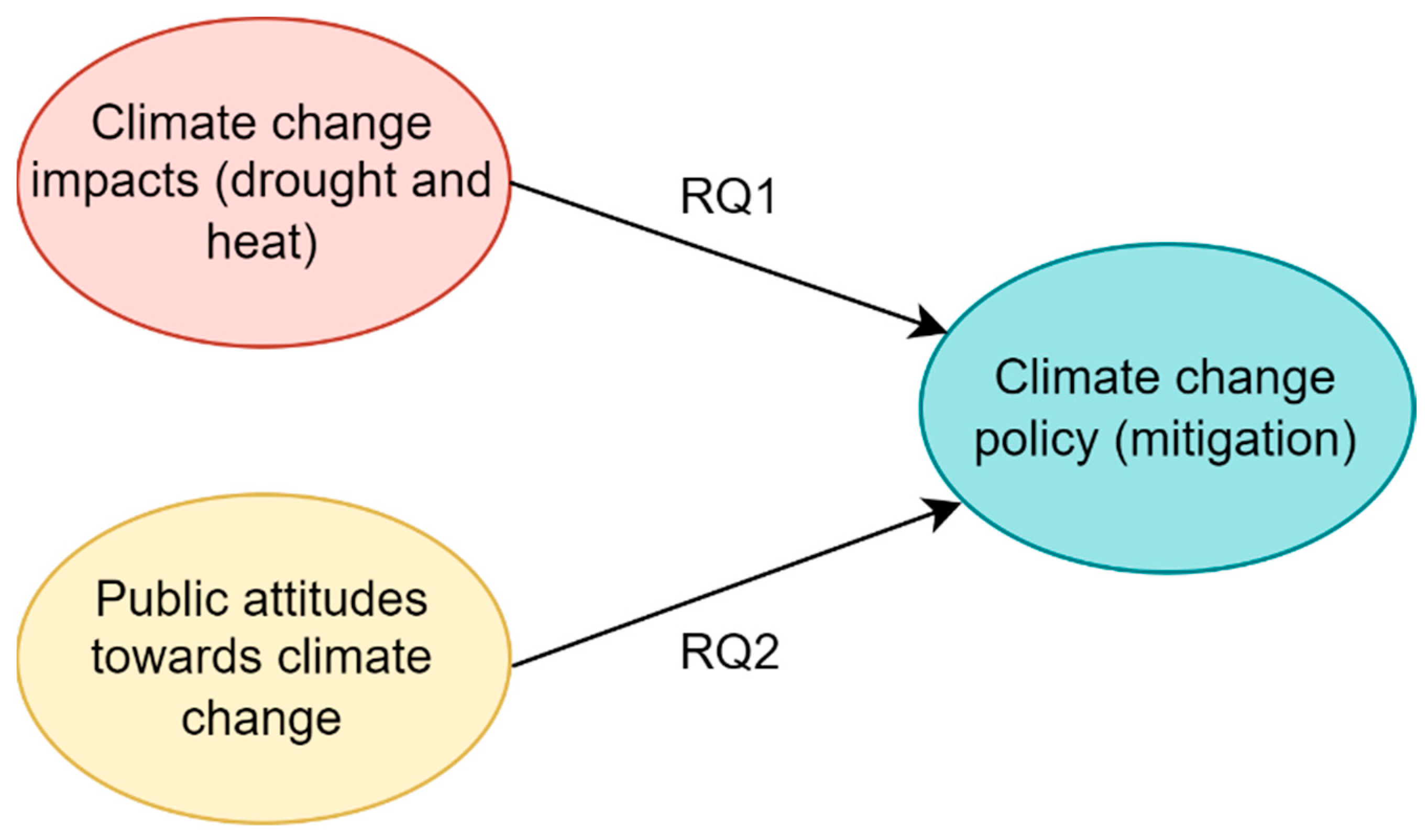
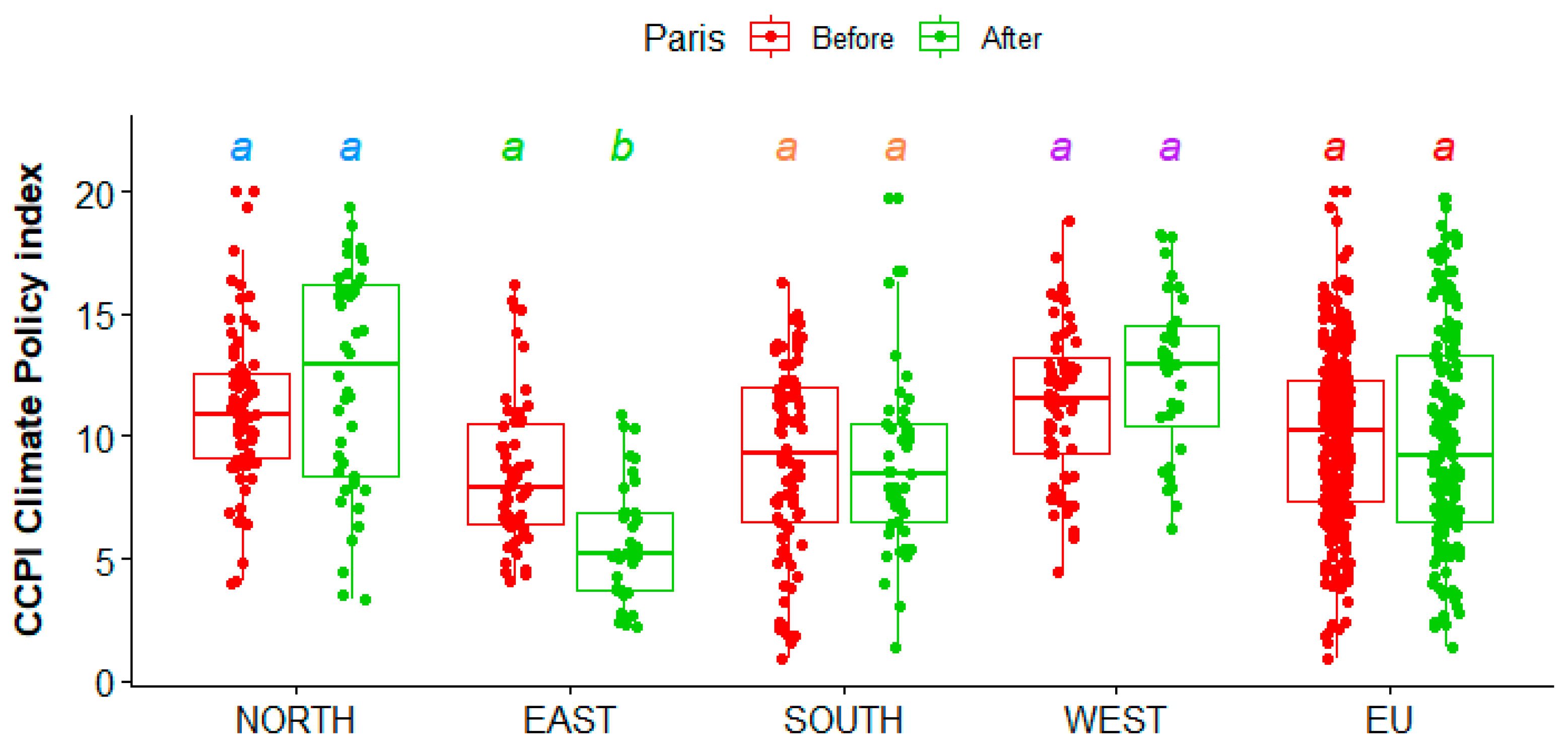
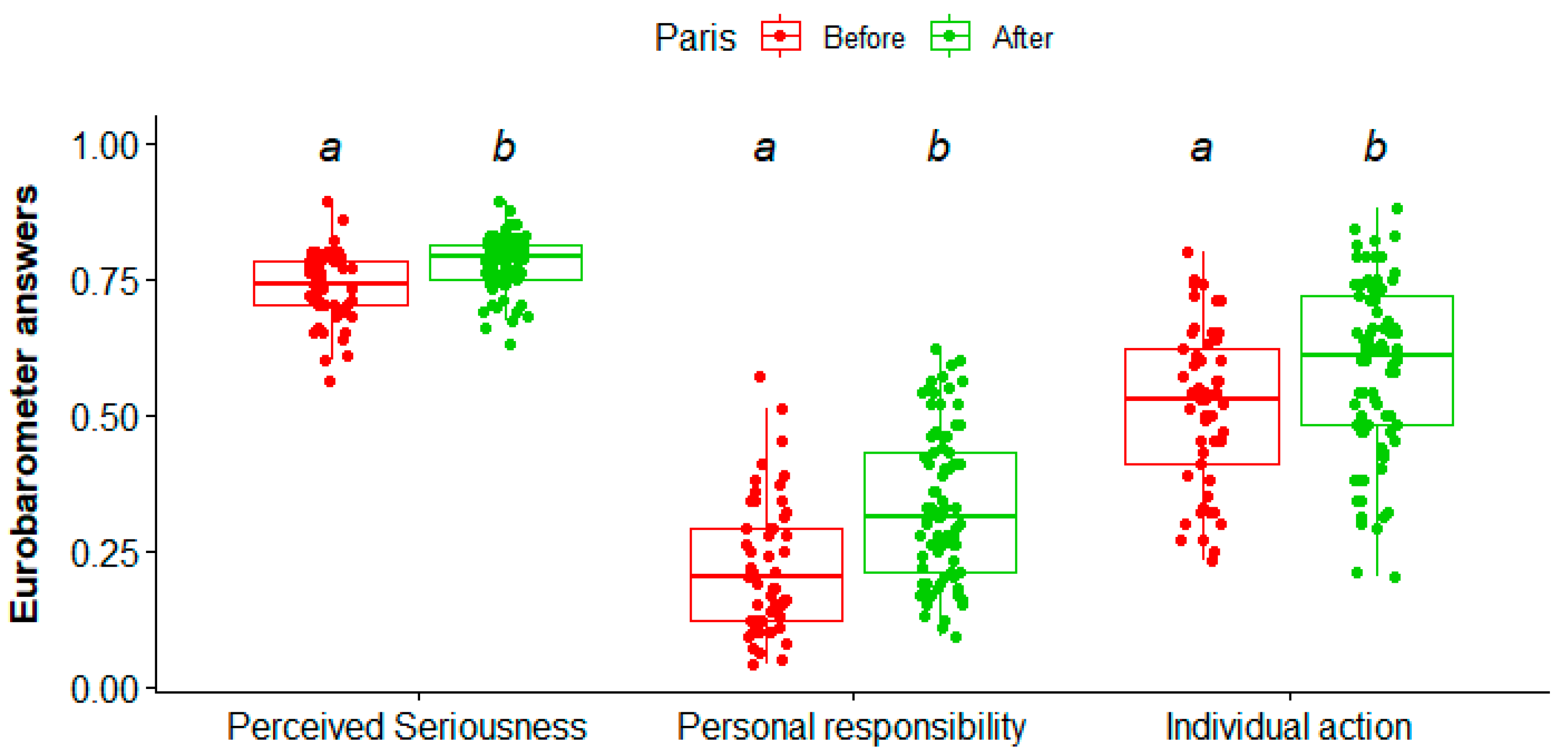



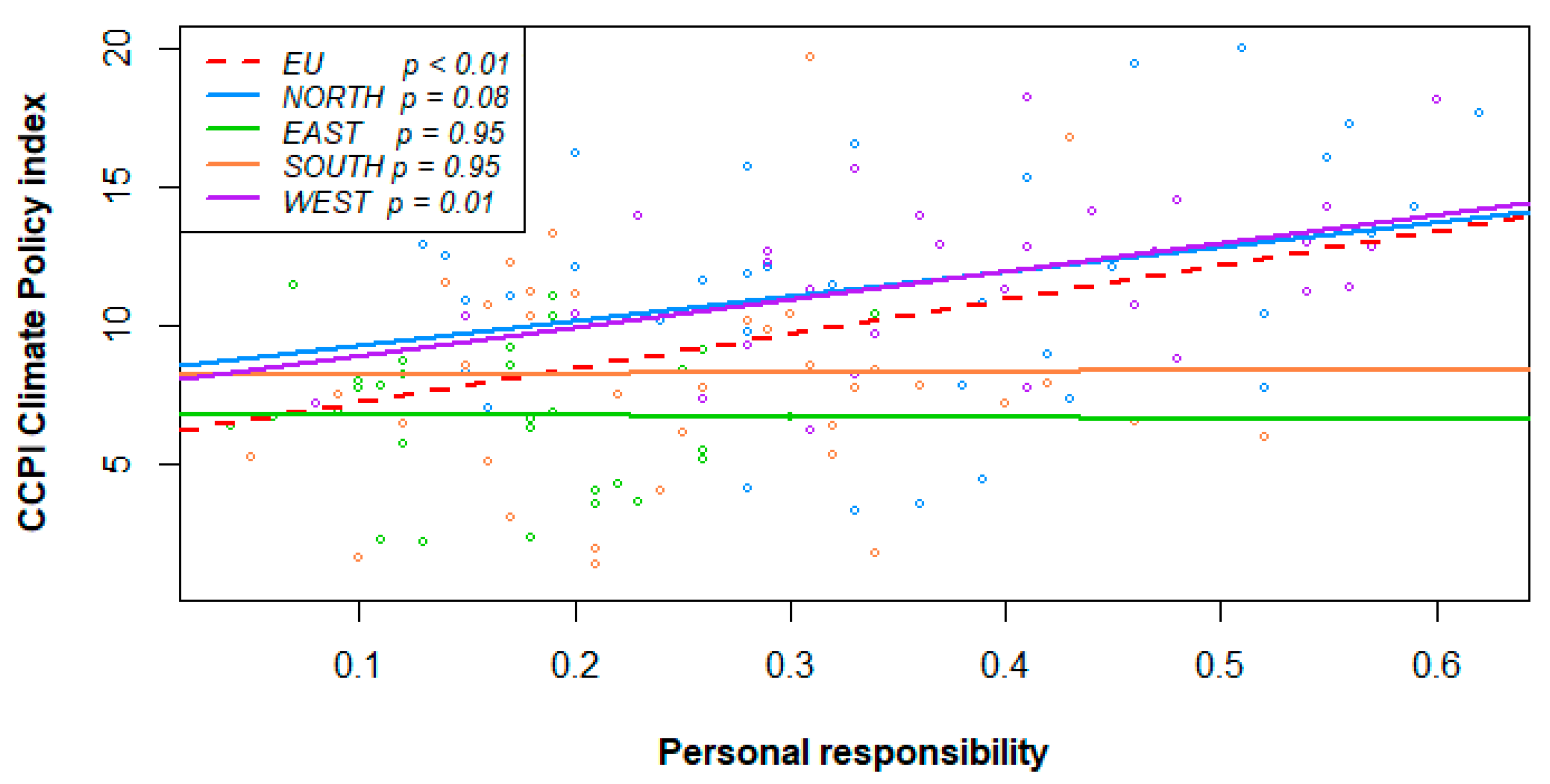
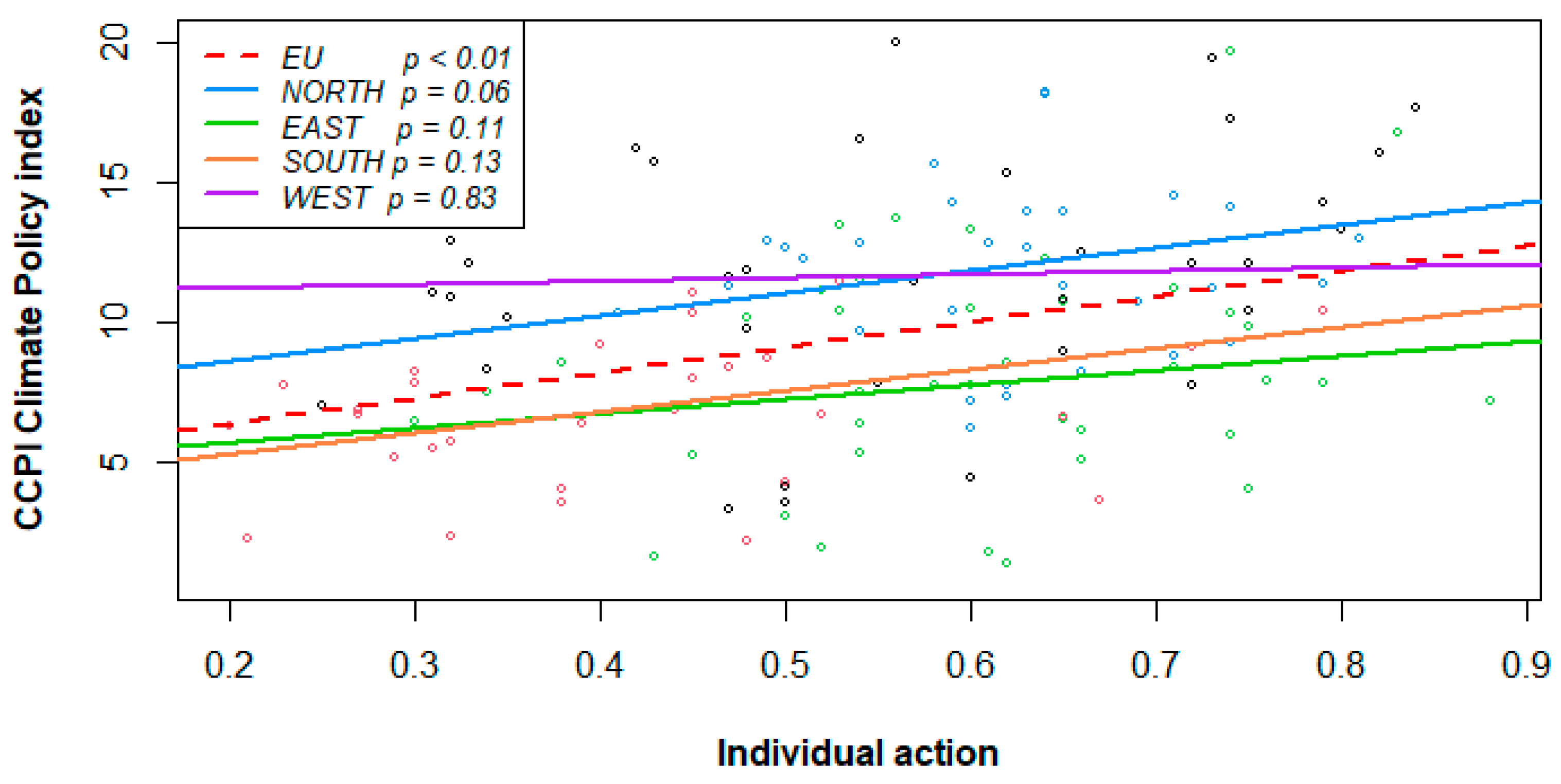
| EU Region | Countries with Individual ND-GAIN Index | Regional ND Gain Mean |
|---|---|---|
| West (6) | France (16), Germany (8), Austria (7), Netherlands (17), Belgium (23), Luxemburg (12) | 14 |
| North (7) | Sweden (4), Denmark (5), Finland (2), Estonia (22), Latvia (35), Lithuania (28), Ireland (21) | 17 |
| South (8) | Croatia (55), Italy (33), Spain (26), Portugal (25), Slovenia (20), Greece (32), Cyprus (43), Malta (36) | 34 |
| East (6) | Bulgaria (54), Czechia (24), Hungary (50), Poland (28), Romania (74), Slovakia (45) | 46 |
| Aspect of Attitudes | North | East | West | South |
|---|---|---|---|---|
| Perceived seriousness of climate change | Average level 2011–2021 LOWEST CONCERN | Average level 2011–2021 MEDIUM CONCERN | Average level 2011–2021 MEDIUM CONCERN | Average level 2011–2021 HIGHEST CONCERN |
| Improvement after Paris agreement (2015): YES | Improvement after Paris agreement (2015): NO | Improvement after Paris agreement (2015): YES | Improvement after Paris agreement (2015): YES | |
| Feeling of personal responsibility for tackling climate change | Average level 2011–2021 HIGHER RESPONSIBILITY | Average level 2011–2021 LOWER RESPONSIBILITY | Average level 2011–2021 HIGHER RESPONSIBILITY | Average level 2011–2021 LOWER RESPONSIBILITY |
| Improvement after Paris agreement (2015): YES | Improvement after Paris agreement (2015): NO | Improvement after Paris agreement (2015): YES | Improvement after Paris agreement (2015): YES | |
| Personal action taken over the past six month to fight climate change | Average level 2011–2021 MEDIUM ACTION | Average level 2011–2021 THE LEAST ACTION | Average level 2011–2021 MEDIUM ACTION | Average level 2011–2021 MEDIUM ACTION |
| Improvement after Paris agreement (2015): NO | Improvement after Paris agreement (2015): NO | Improvement after Paris agreement (2015): YES | Improvement after Paris agreement (2015): YES |
Disclaimer/Publisher’s Note: The statements, opinions and data contained in all publications are solely those of the individual author(s) and contributor(s) and not of MDPI and/or the editor(s). MDPI and/or the editor(s) disclaim responsibility for any injury to people or property resulting from any ideas, methods, instructions or products referred to in the content. |
© 2023 by the authors. Licensee MDPI, Basel, Switzerland. This article is an open access article distributed under the terms and conditions of the Creative Commons Attribution (CC BY) license (https://creativecommons.org/licenses/by/4.0/).
Share and Cite
Nayna Schwerdtle, P.; Cavan, E.; Pilz, L.; Oggioni, S.D.; Crosta, A.; Kaleyeva, V.; Karim, P.H.; Szarvas, F.; Naryniecki, T.; Jungmann, M. Interlinkages between Climate Change Impacts, Public Attitudes, and Climate Action—Exploring Trends before and after the Paris Agreement in the EU. Sustainability 2023, 15, 7542. https://doi.org/10.3390/su15097542
Nayna Schwerdtle P, Cavan E, Pilz L, Oggioni SD, Crosta A, Kaleyeva V, Karim PH, Szarvas F, Naryniecki T, Jungmann M. Interlinkages between Climate Change Impacts, Public Attitudes, and Climate Action—Exploring Trends before and after the Paris Agreement in the EU. Sustainability. 2023; 15(9):7542. https://doi.org/10.3390/su15097542
Chicago/Turabian StyleNayna Schwerdtle, Patricia, Edwige Cavan, Lukas Pilz, Silvio Daniele Oggioni, Arianna Crosta, Veranika Kaleyeva, Peshang Hama Karim, Filip Szarvas, Tobiasz Naryniecki, and Maximilian Jungmann. 2023. "Interlinkages between Climate Change Impacts, Public Attitudes, and Climate Action—Exploring Trends before and after the Paris Agreement in the EU" Sustainability 15, no. 9: 7542. https://doi.org/10.3390/su15097542
APA StyleNayna Schwerdtle, P., Cavan, E., Pilz, L., Oggioni, S. D., Crosta, A., Kaleyeva, V., Karim, P. H., Szarvas, F., Naryniecki, T., & Jungmann, M. (2023). Interlinkages between Climate Change Impacts, Public Attitudes, and Climate Action—Exploring Trends before and after the Paris Agreement in the EU. Sustainability, 15(9), 7542. https://doi.org/10.3390/su15097542







